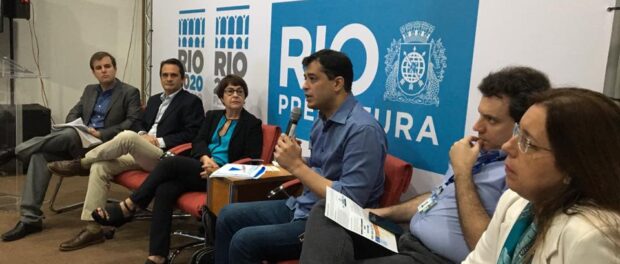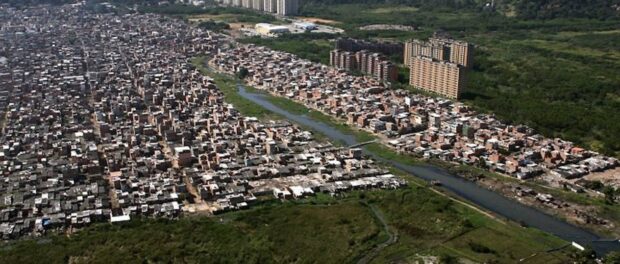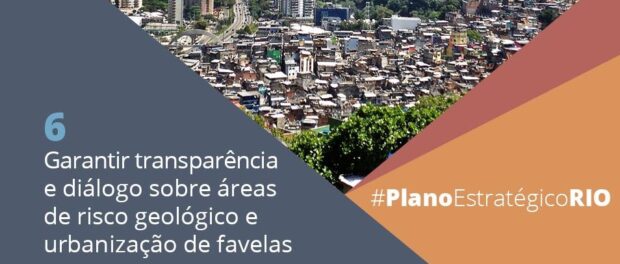
The Organic Law of Rio de Janeiro requires the municipal administration to develop a Strategic Plan for its term in power, and furthermore, to promote a consultation process with the population’s participation in validating the proposed goals. This process for the Strategic Plan elaborated by Rio’s near mayor Marcelo Crivella ended on September 29. RioOnWatch previously analyzed the goals related to favelas, as well as the goals that were not focused on these spaces but which we believe should have been due to the specificities of these territories.
Additionally, Casa Fluminense and 32 other diverse organizations—such as Meu Rio, Rio de Janeiro’s Council of Architecture and Urbanism (CAU), Redes da Maré, Observatório de Favelas, Catalytic Communities (CatComm), Igarapé, Verdejar, and IBASE—promoted meetings and debates in various locations throughout Rio to supplement those organized by the City. These meetings took place over the last three months, aiming to create proposals that reflect the concerns and needs of citizens. Due to the absence of an effective participatory process organized by the City of Rio, this civil society-led process ended up also serving as a space for listening to and discussing the repercussions of proposals suggested by citizens. The document summarizing the results of these meetings was sent to the City government, and a petition for the inclusion of the goals proposed by the population can be signed here.
The City itself did organize meetings to discuss the plan with the population, but due to low publicity, the public at these events consisted principally of municipal employees, who were invited and let off work in order to attend. Additionally, changes in the locations of the events were not adequately publicized, leading many residents to show up at the wrong place, where there was no information to redirect them, thus damaging the participatory process. The forums occurred in Centro, Tijuca, Bonsucesso, Freguesia, and Del Castilho, among others. “I suggest they hold public audiences in favelas, because many [residents] are not even aware of these hearings,” said Emília Souza, a resident of Horto and a leader in its Residents’ Association, during the public audience in Tijuca.
“Favelas need to be respected and the projects need to be discussed with the people who are affected by them—preferably, within the favelas. It is not possible for the benefits to only reach 21 of all the favelas in Rio de Janeiro,” another resident said, alluding to the goal to upgrade 21 favelas (goal #73) in a city that contains, according to the official narrative, more than 800 favelas. “We want to participate effectively in the construction of the Plan and not just come to a hearing to legitimize what has already been established,” a third resident insisted.
Spectators further complained that the presentation of the plan took nearly two of the three hours allocated for the event, thus reducing time for participation and debate. “The people only put forth their opinions and there was no debate,” said an advocate from the Land and Housing Nucleus (NUTH) of the Public Defender’s Office. “Even so, many parts of the Plan on paper are already being initiated, even before the end of the participatory process. Look at the case of [the favela of] Rio das Pedras—it seems unreal, but it could actually come to pass [that residents will be displaced as part of an upgrading plan],” she added, referring to the fact that municipal employees have begun registering residents of that community, asking questions regarding their incomes and the number of floors and rooms in their homes.
The plan calls for the conclusion of a study on urban requalification (goal #74 in the plan), which could allow a change in the Rio das Pedras region’s building restrictions, expanding the limit from two floors to twelve. The City’s actions indicate that the process for the resettlement of residents in the planned new buildings has already begun, even before the study has been completed. “It’s all done in a hidden manner, without criteria. We discovered that this was happening through the media, putting the pieces together. One day we woke up in this nightmare,” a resident of Rio das Pedras said about the situation, during a meeting sponsored by the NUTH and the Pastoral das Favelas in order to discuss the consequences of the plan.
Residents of Rio das Pedras are already organizing against the imminent removals. “This plan is not for us, it is for our neighbors. They only use us as ‘make-up’—as a cover. They want to build a building with an elevator for a population that cannot pay R$400 in rent, let alone the electricity bill to maintain the elevator, the condominium fee…” said Mário, one of the leaders of the movement.
“One struggle of the people who live in a favela is to simply continue living where they are. They want a public square, uncomplicated housing, they want upgrades. The Municipal Housing Secretariat (SMH) cannot be a Municipal Evictions Secretariat. The secretariats need to enter the favelas and work. The people who know what the favela needs are the residents, so listen to them, listen to the residents’ pains, climb the hills [into the communities],” demanded one favela resident at the event in Tijuca. “It is hypocrisy to look at the favela as an afterthought. We need to care for green spaces, for security and for infrastructure in general. Those who live there are part of the social context, we are the people who work in order for this city to function. We favela residents have the right to the best,” said another resident at the same event.
Beyond the in-person meetings, the City promised an online platform to collect suggestions from the public. This was only online for the first of four phases promised by the City and did not cover the whole consultation process. Only 354 people participated, the majority of whom were from the South Zone. On the platform, it was only possible to evaluate the city’s weak or strong points based on a set of given statements (which reinforced stereotypes). There was no space to include new points or to evaluate the proposed goals, thus it can hardly be considered a satisfactory process of engagement with the Plan itself.
“I still dream of a plan which treats the favela as an integral and true part of the city. The favela appears timidly in the plan, and when it appears, there are questions regarding the numbers involved,” a resident said during one of the events promoted by the network of civil society organizations, in partnership with MobiRio and Rio de Janeiro’s Council of Architects at the Brazilian Institute of Architects. At the same event, Aspásia Camargo, the Planning subsecretary who is responsible for the Plan, commented on the process: “Participatory debate is like medicine: too much kills you,” revealing the stance of the City government regarding true participatory engagement.
Other debates promoted by civil society included the Meeting of Favelas to Debate the Strategic Plan, held in Complexo da Maré in partnership with Redes da Maré, and a civil society meeting in Campo Grande to discuss urban agriculture, which is absent from the plan. The document synthesizing these meetings addresses the territorialization of goals that originally did not take into account the specificities of favelas, such as: the one regarding group coverage in the Saúde da Família health program (goal #15), expanded to cover not only neighborhoods with low development indicators, but also favelas; the need for education goals to reflect that, in addition to sharing the same challenges facing the rest of the city, schools in favelas also have the challenge of meeting the full required schedules and number of school days (goal #31); the need to increase recycling facilities for favelas (goal #51); to provide technical orientation for sustainable construction specifically in favelas (goal #60); and to encourage travel by bike in and around favelas (goal #83).
After submitting the document with commentary on the goals resulting from this civil society-led process, the participating organizations chose 12 goals to prioritize and organized a petition demanding that the municipality include these priorities in the plan. The 12 goals include the need for transparency and dialogue regarding favela upgrading and areas of geological risk; the need to make public the selection criteria for the 21 favelas chosen to receive interventions and information on how upgrades will be implemented (current goal #73); and need to guarantee that environmental discourse and the historical trend of exaggerating risks are not used to justify removals (current goal #76). “We hope that the City has more sensitivity toward issues regarding favelas, considering the approaches of previous administrations. What we’re living is a distortion of environmental rights in the way communities in these areas are treated and in the way that the elites who live in these areas benefit,” Emília Souza said at the forum in Tijuca.
The 12 points also include the expansion of sewage collection and treatment for the whole city, including favelas, and not only for the AP4 region (Barra de Tijuca and Jacarepaguá), as is currently proposed in Strategic Plan goal #52. They also call for the expansion of the security goal to include areas with the worst indicators and not only beachfront areas as is proposed in the original Plan (goal #43). The goals also include the delivery of social interest housing in the city center. And finally, the goals propose a program to develop culture as a means to reduce social inequalities in the city; this program would reaffirm cultural production in favelas as a way to challenge the City’s discourse (and the practices based on that discourse) that there is no culture in these areas. “Culture can resolve many issues, including violence, in addition to generating employment for favela youth,” explained a resident at the event in Tijuca.




